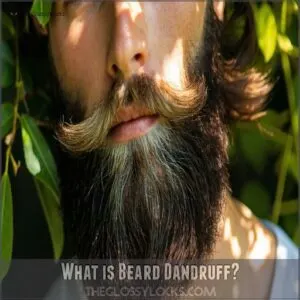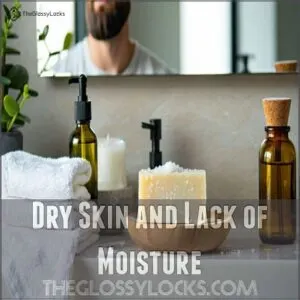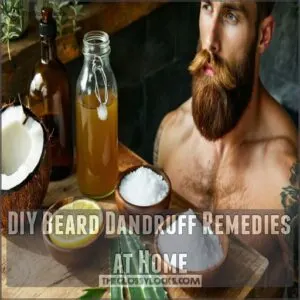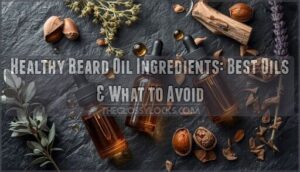This site is supported by our readers. We may earn a commission, at no cost to you, if you purchase through links.
 To get rid of beard dandruff naturally, start by brushing your beard daily to loosen flakes.
To get rid of beard dandruff naturally, start by brushing your beard daily to loosen flakes.
Wash it with a gentle, pH-balanced cleanser—don’t go overboard or you’ll dry out your skin. Moisturize with coconut or jojoba oil to lock in hydration, and try tea tree oil for its antifungal superpowers.
Exfoliate using a soft beard brush to remove dead skin, and consider a splash of diluted apple cider vinegar to balance your skin’s pH.
Oh, and don’t forget your diet—load up on omega-3s and vitamins like biotin and zinc. Consistency is key, and your beard will thank you!
Table Of Contents
- Key Takeaways
- What is Beard Dandruff?
- Causes of Beard Dandruff
- How Often to Wash Your Beard
- Natural Oils for Beard Dandruff Relief
- DIY Beard Dandruff Remedies at Home
- Role of Diet in Preventing Beard Dandruff
- Maintaining a Healthy, Flake-Free Beard
- Frequently Asked Questions (FAQs)
- How do you get rid of dandruff in your beard?
- How do I get rid of dry, flaky skin under my beard?
- What causes facial dandruff?
- How often should I wash my beard if I have dandruff?
- Can beard dandruff cause hair loss over time?
- Are there specific fabrics that irritate beard dandruff?
- How do sweat and exercise impact beard dandruff?
- Can hydration levels affect beard dandruff severity?
- Are scented beard products linked to beard dandruff?
- Conclusion
Key Takeaways
- Exfoliate your beard daily with a soft beard brush to loosen flakes and promote healthy skin.
- Wash your beard 2-3 times a week with a gentle cleanser and avoid harsh products that dry out your skin.
- Moisturize with natural oils like coconut or jojoba daily, and use tea tree oil for its antifungal properties.
- Balance your skin’s pH using diluted apple cider vinegar, and maintain a nutrient-rich diet with omega-3s, biotin, and zinc to support skin and hair health.
What is Beard Dandruff?
If you’ve noticed white flakes falling from your beard like a tiny snowstorm, you’re dealing with beard dandruff, a common condition that makes the skin under your facial hair dry and itchy.
Just like the dandruff on your scalp, these pesky flakes can make your otherwise awesome beard look messy, but don’t worry—they’re totally treatable with the right care.
Common Symptoms and Warning Signs
Got an itchy, flaky beard that’s driving you nuts? Those pesky white flakes and persistent beard discomfort aren’t just annoying – they’re your skin’s way of waving a red flag.
Watch out for itchy beard patches paired with redness under beard areas. Weather-related symptoms can make things worse, especially during seasonal changes.
If you notice skin flakes with seborrheic dermatitis symptoms like scaly patches, it’s time to take action. Understanding seborrheic dermatitis is vital to addressing the root cause of your beard dandruff.
How It Differs From Scalp Dandruff
Beard dandruff isn’t the same beast as scalp dandruff.
While scalp issues often stem from oily skin, beard dandruff thrives on dryness, thanks to your hair texture, follicle shape, and beard’s tricky location.
The sensitive skin beneath needs gentler care to fight yeast sensitivity, seborrheic dermatitis, and Malassezia globosa.
Dry skin and harsh shampoos are common triggers that exacerbate the condition.
Stick to natural remedies and a smart beard care routine for relief.
Causes of Beard Dandruff
Beard dandruff happens when your skin gets too dry or fungus and yeast start causing trouble under your facial hair.
Factors like harsh products, stress, or even your diet can also make those pesky flakes appear.
Dry Skin and Lack of Moisture
Dry skin triggers beard dandruff, often worsened by harsh cleansers or skipping hydrating steps.
Combat flaky skin by using natural moisturizers like jojoba oil or coconut oil—both seal in moisture beautifully.
Add a natural beard wash to your routine and exfoliate gently with natural exfoliators. Simple moisturizing beard techniques like applying oil after washing keep skin hydrated and healthy.
Yeast Infections and Fungal Growth
Fungal overgrowth often starts with Malassezia globosa feeding on skin oils, triggering irritation and flakes.
Yeast overgrowth causes itchiness and dryness, especially under beards.
Combat this with antifungal skincare tips like using shampoos with ketoconazole or selenium sulfide. Natural remedies boasting antifungal properties, such as tea tree oil, work wonders.
Managing fungal outbreaks guarantees you kick those annoying fungal irritants away!
Skin Conditions Like Seborrheic Dermatitis
Seborrheic dermatitis is one of the chronic dandruff causes that messes with your beard game.
It leads to flakes, greasy patches, and redness.
Tackle it with these skin irritation solutions:
- Use antifungal shampoos for their soothing properties.
- Apply aloe vera gel for natural remedies with a cooling touch.
- Opt for gentle, natural beard care to protect skin health.
Diet, Stress, and Lifestyle Factors
Skipped the medical side? Let’s talk about what you eat and how you live.
A nutrient-rich diet with omega-3 fatty acids strengthens skin. Stress impact skincare? Big time—it triggers dandruff!
Try stress management through relaxation for skin health. Balanced daily habits like hydration and sleep matter.
Focus on an antidandruff diet with vegetables, berries, and zinc-packed foods.
How Often to Wash Your Beard
Washing your beard too often can dry out your skin, but skipping washes completely can lead to buildup and flakes.
Finding the right balance is key to keeping your beard clean, healthy, and dandruff-free.
Finding The Right Washing Schedule
Washing your beard too little or too often messes with its health.
Aim for the optimal beard wash frequency based on your skin type:
- Dry skin? Once or twice a week.
- Oily? Stick to 3-4 times weekly.
- Normal folks, 2-3 times is perfect.
Adjust as seasons change.
Use a natural beard wash to avoid overwashing risks.
Choosing a Gentle Beard Shampoo or Wash
Pick a sulfate-free beard shampoo or natural beard wash with a pH balance gentle on your skin.
Look for active ingredients like ketoconazole or zinc to fight flakes. Avoid harmful chemicals; they can worsen sensitive skin.
Understanding your beard washing frequency is vital to maintain a healthy beard. Massage it in for five minutes, rinse well, and enjoy a flake-free beard.
It’s an easy step in beard grooming!
Natural Oils for Beard Dandruff Relief
Natural oils like coconut, jojoba, and tea tree oil can work wonders for tackling beard dandruff.
They’re simple, effective, and keep your beard looking smooth while soothing the skin underneath.
Benefits of Coconut Oil and Jojoba Oil
Coconut oil and jojoba oil are powerhouse natural remedies for beard dandruff. They’re perfect for skin hydration and beard nourishment without clogging pores.
Coconut oil softens skin, fights flakes, and protects hair, while jojoba oil absorbs quickly for a non-greasy finish. Using coconut oil benefits can lead to healthier hair follicles and improved beard appearance.
- Coconut oil promotes hair growth and soothes irritation.
- Jojoba oil matches skin’s natural oils.
- Both target stubborn flakes effortlessly.
Using Tea Tree Oil as a Remedy
Tea tree oil’s antifungal properties make it a standout in beard dandruff remedies.
Mix a few drops with a carrier like jojoba or coconut oil for a natural antidandruff beard oil. This oil blend acts as a fungal treatment and skin soother, improving beard hygiene.
For more information on Tea Tree Oil benefits, consider exploring its uses. But don’t overdo it—tea tree is powerful, so keep the dilution right!
DIY Beard Dandruff Remedies at Home
You don’t need fancy products to tackle beard dandruff—your kitchen has some powerful solutions ready to go.
With simple ingredients like apple cider vinegar and aloe vera, you can soothe your skin and keep those flakes at bay.
Apple Cider Vinegar for PH Balance
When beard oils aren’t cutting it, apple cider vinegar steps in like the hero your face needs.
Its acid regulation helps balance pH levels, tackling beard dandruff at its roots.
For more on apple cider products, consider exploring various remedies.
Mix equal parts vinegar and water, then gently massage it in. Let it sit a few minutes before rinsing.
This natural skincare trick keeps flakes at bay!
Aloe Vera Gel for Itchy, Irritated Skin
Feeling itchy from beard dandruff? Aloe vera gel brings quick relief with its soothing properties.
Loaded with antioxidants and moisture-boosting aloe properties, it calms irritation without clogging pores.
Additionally, using a beard care balm can help moisturize the skin underneath the beard, reducing itch and dandruff.
Here’s how to use it:
- Apply a small amount of aloe vera gel to your beard.
- Gently massage into the skin.
- Leave for 15 minutes.
- Rinse with lukewarm water.
Exfoliation With Beard Brushes or Scrubs
Wave goodbye to beard flakes with a good exfoliation routine!
Use a beard scrub or a soft-bristle brush to remove dead skin cells and loosen stubborn dandruff.
Gentle scrubbing promotes skin renewal and keeps irritation at bay.
For effective beard care, utilizing a beard scrub product can make a significant difference.
Add a daily massage to boost circulation under your beard.
These simple beard brushing techniques are game-changers in beard dandruff remedies—flakeless and fresh!
Role of Diet in Preventing Beard Dandruff
What you eat plays a huge role in keeping your beard flake-free and your skin healthy.
By adding foods rich in biotin, zinc, and vitamins to your meals, you can nourish your skin and prevent those pesky flakes from forming.
Foods That Improve Skin and Hair Health
Nutrient-rich foods like salmon, sweet potatoes, avocados, and nuts aren’t just tasty—they’re skin-boosting powerhouses.
Packed with omega-3 fatty acids, vitamins, and minerals, they promote healthy skin and hair.
Snack on sunflower seeds or whip up an avocado toast for antioxidant benefits.
Adding leafy greens like spinach to your meals can further boost skin health due to their rich iron and vitamin A content.
A balanced diet leads to flake-free beards, proving that healthy hair snacks can work wonders!
Essential Vitamins Like Biotin and Zinc
If you aim for a healthy beard, don’t skip vitamins.
Biotin strengthens hair, stopping breakage, while zinc prevents flaky skin.
Together, they’re your go-to for beard health.
Think of them as food for your face, found in nuts, seeds, and leafy greens.
Missing these nutrients? It’s like building a house without bricks – expect issues!
Maintaining a Healthy, Flake-Free Beard
Keeping your beard healthy and flake-free isn’t as complicated as it might seem.
With the right products and a simple routine, you can say goodbye to those pesky white flakes for good.
Incorporating Beard Balms Into Your Routine
Adding a soothing beard balm to your routine can work wonders for beard hygiene and banishing flakes.
Here’s how:
- Choose an ideal balm: Look for natural oils like jojoba or shea butter in the ingredients.
- Focus on application techniques: Warm it in your palms, then massage evenly into your beard.
- Enhance beard texture: Balms lock in moisture and keep stray hairs tamed.
Hydration and Moisturization Techniques
You’ve got your beard balm routine down, but hydration’s your next best friend.
Use moisturizing beard oils like jojoba or argan to lock in that moisture after cleansing.
Don’t skip hydrating facial skin—apply natural oils to prevent dryness.
These beard dandruff remedies work wonders when paired with ideal moisture balance.
It’s the easy dry skin solution your beard craves.
Adapting Beard Care to Seasonal Changes
Cold winters and humid summers can mess with your beard game.
In winter, dry air zaps moisture, leading to flakes—use natural oils like jojoba and coconut for hydration.
Summer? Sweat and humidity can clog pores, so wash with a gentle beard scrub.
Seasonal changes demand climate adaptation. Stick to your beard grooming tips, and you’re ready for anything!
Frequently Asked Questions (FAQs)
How do you get rid of dandruff in your beard?
Start by washing your beard gently with a natural shampoo twice a week.
Use beard oil (like jojoba or coconut) daily to moisturize, exfoliate with a brush, and try tea tree oil for stubborn flakes.
How do I get rid of dry, flaky skin under my beard?
Tackle dry, flaky skin under your beard by exfoliating with a gentle beard brush.
Moisturizing with natural beard oil like jojoba or coconut is also essential.
Washing 2-3 times weekly using mild, hydrating beard shampoo is another crucial step.
What causes facial dandruff?
Facial dandruff happens when dry skin, fungal overgrowth, or conditions like seborrheic dermatitis trigger flaky, itchy patches under your beard.
Harsh grooming products, poor hydration, or stress can also throw your skin’s balance off.
How often should I wash my beard if I have dandruff?
Wash your beard 2-3 times a week with a gentle, natural shampoo.
Overwashing strips oils, making dandruff worse, but skipping too many washes leaves flakes.
Find a balance that keeps your beard clean and moisturized.
Can beard dandruff cause hair loss over time?
Beard dandruff itself doesn’t cause hair loss, but constant scratching can damage hair follicles, leading to thinning over time.
Treat dandruff early to keep your beard healthy, itch-free, and strong — no unnecessary hair drama!
Are there specific fabrics that irritate beard dandruff?
Certain fabrics like wool or synthetic materials can irritate your skin and worsen beard dandruff.
Stick to softer, breathable options like cotton.
They’re kind to your skin and help your beard stay itch-free and flake-free!
How do sweat and exercise impact beard dandruff?
Sweat and exercise can make beard dandruff worse by trapping moisture and irritating your skin.
Wash your beard after workouts, moisturize, and avoid harsh products to keep it clean and flake-free.
Can hydration levels affect beard dandruff severity?
Think of your skin like a thirsty plant — if you’re not drinking enough water, your beard’s skin won’t stay hydrated either.
Poor hydration worsens dryness and flakes, making proper water intake key for healthy facial hair.
Are scented beard products linked to beard dandruff?
Yep, scented beard products can trigger dandruff if they contain harsh chemicals or synthetic fragrances that irritate your skin.
Always check labels and stick to natural, skin-friendly products to avoid unnecessary itch and flakes.
Conclusion
Think of your beard as a garden—it thrives with care and attention.
To get rid of beard dandruff naturally, stick to these simple remedies: cleanse gently, moisturize with natural oils, exfoliate regularly, and balance your skin’s pH with solutions like apple cider vinegar.
Pair these steps with a nutrient-rich diet and consistent effort, and those flakes won’t stand a chance.
Embrace the routine, and your beard will reward you with a fresh, flake-free shine.














